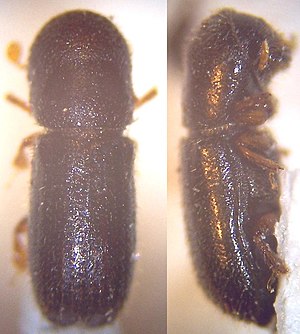Small wood drill
| Small wood drill | ||||||||||||
|---|---|---|---|---|---|---|---|---|---|---|---|---|

Small wood drill |
||||||||||||
| Systematics | ||||||||||||
|
||||||||||||
| Scientific name | ||||||||||||
| Xyleborus saxeseni | ||||||||||||
| ( Ratzeburg , 1837) |
The small wood borer ( Xyleborus saxeseni ) is a weevil from the subfamily of the bark beetle (Scolytinae). Since it creates its breeding systems in the wood of the host trees, it is assigned to the wood breeders. He's an ambrosia beetle .
features
The beetles are 1.5 to 2.4 millimeters long and have a cylindrical body. The pronotum is strongly flattened, hunched and arched, longer than wide, rounded in front, cylindrical, with a conical arch in front of the middle and conceals the head when viewed from above. The front edge is smooth and without a crown of cusps. It is only grained behind the front edge. The wing-coverts are far down, the hind wings are only rudimentary , so the beetle is unable to fly. The front hips are wide apart. The abdomen remains straight from the second sternite towards the end. The third tarsal link is cylindrical in shape. The antenna lobes are broad, the antenna whip is five-membered.
Male and female animals differ in appearance ( sexual dimorphism ). The male is significantly smaller than the female. Its pronotum is longer than it is broad, slightly arched, humped at the front and, like the elytra, is finely haired. The crash is finely dotted. The male beetles are yellow-brown in color. They reach a body length of 1.5 to 1.8 millimeters. The pronotum of the females is very slightly arched, longer than it is broad and smooth at the back. The fall is matte, with a fine row of grains at the seam and the third space between the rows of dots. It is dark brown in color, but the head and pronotum are lighter and the antennae and legs are yellowish. Their body length is two to 2.4 millimeters.
distribution
The species is common in Europe .
Way of life
Xyleborus saxeseni comes from oaks ( Quercus ), hornbeams ( Carpinus ), ash trees ( Fraxinus ), elms ( Ulmus ), birches ( Betula ), alders ( Alnus ), poplars ( Populus ), chestnuts ( Castanea ), walnuts ( Juglans ), dogwood ( Corylus ), linden ( Tilia ), willows ( Salix ), apples ( Malus ), pears ( Pyrus ) and Prunus , occasionally on pines ( Pinus ), larches ( Larix ), spruces ( Picea ), cedars ( Cedrus ), firs ( Abies ) and hemlocks ( Tsuga ). It colonizes the wood of the trees. The feeding picture has an entrance tube from which branched or square-shaped brood tubes ( family square corridor ) lead into the wood. The animals are polyphagous wood breeders. There are one to two generations a year with a flight time in April and June. The beetles do not look after their brood, but indirectly their food. They drill a system of ducts into the wood in which they lay the eggs and grow an ambrosia mushroom in it, the spores of which they carry around in their stomach. The larvae feed on these fungi. The parents ensure the correct humidity by plugging or opening the entrance tube with drilling dust and also sort out bacterial foci and other molds. The drilling activity causes technical damage in the wood, which is only of importance if the wood is stored unprocessed for a long time. Dried out and treated wood is not colonized. However, the beetle is considered to be of little importance in terms of wood damage.
Systematics
Synonyms
The following synonyms are known from the literature for Xyleborus saxeseni :
- Xyleborinus alni Niijima, 1909
- Bostrichus saxeseni Ratzeburg, 1837
- Tomicus dohrni Wollaston, 1854
- Bostrichus decolor Boildieu, 1859 for the male
- Xyleborus dryographus Ferrari, 1867 for the female
- Xyleborus aesculi Ferrari, 1867
- Xyleborus subdepressus Rey, 1883
swell
Individual evidence
- ^ Xyleborus saxeseni (Ratzeburg 1837). Fauna Europaea, Version 1.3, April 19, 2007 , accessed on October 23, 2008 .
literature
- Sabine Grüne : Handbook for the determination of the European bark beetles . M. & H. Schaper Verlag, Hannover 1979, ISBN 3-7944-0103-4
- Edmund Reitter : Fauna Germanica - The beetles of the German Empire . Volume 5 p. 294, KG Lutz, Stuttgart 1916
- Edmund Reitter: Fauna Germanica - The beetles of the German Empire . 5 volumes, Stuttgart KG Lutz 1908–1916, digital library volume 134, Directmedia Publishing GmbH, Berlin 2006, ISBN 3-89853-534-7